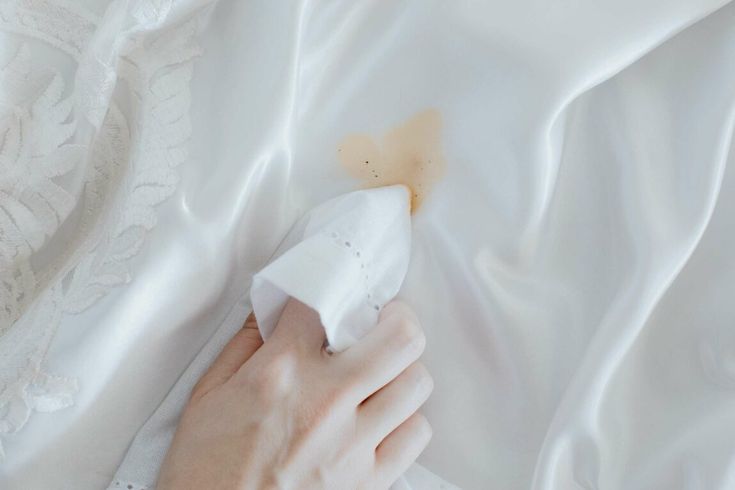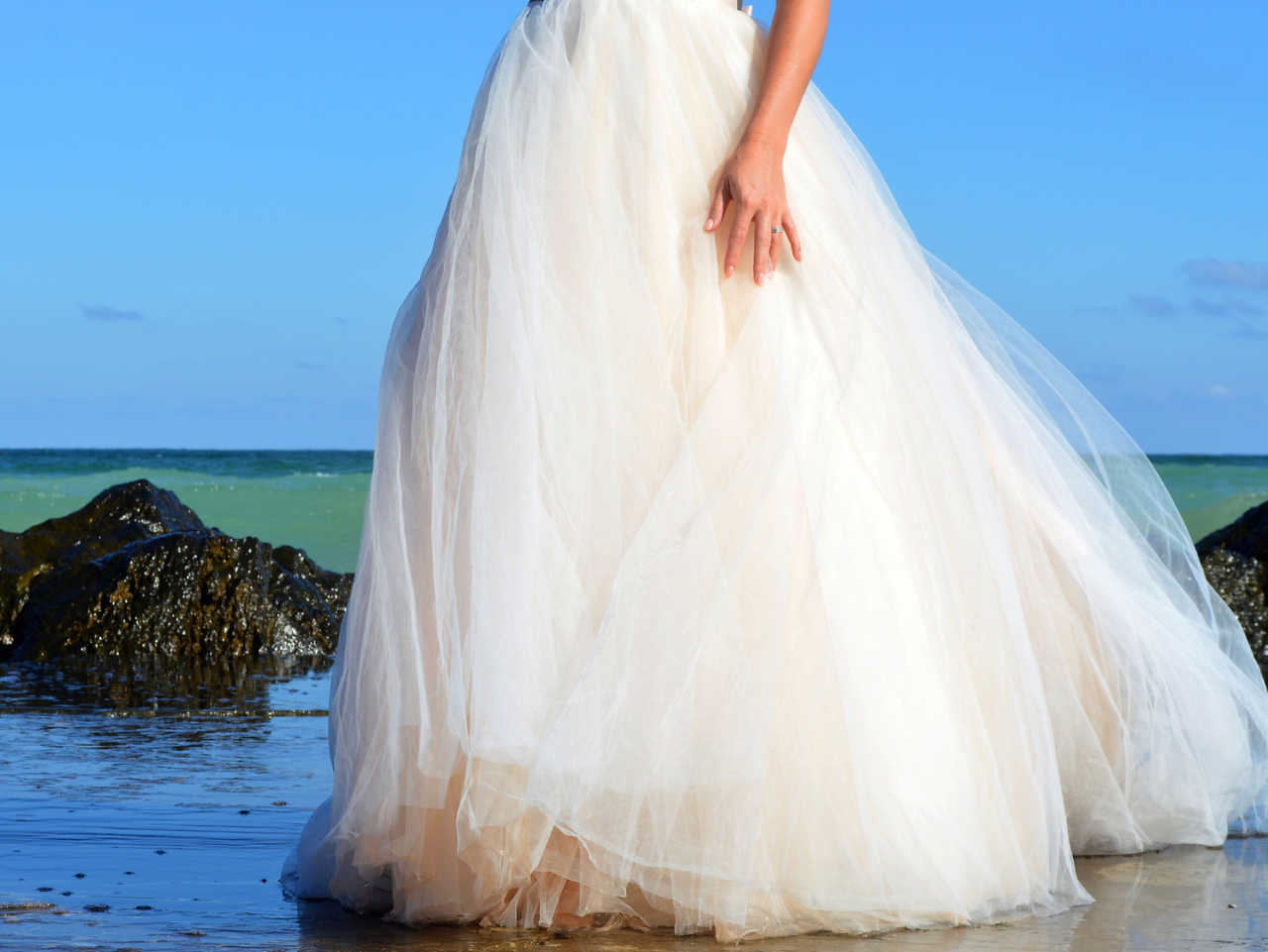It’s almost always expected for dresses to pick up a little sand or grass during a traditional ceremony. However, when your dream wedding unfolds on a breezy, beautiful beach, your dress is up against a unique set of unexpected risks — stains you might not notice until days (or even weeks) later.
For brides who plan to preserve their dress as a keepsake (or hope to repurpose it down the road), this delayed staining can be a major stressor. And understandably so. After all, your wedding dress is unlike any other dress you’ll ever own. It’s special. It’s deeply personal.
So, how can you protect something so special from the beach elements? It starts by knowing exactly what hidden stains you’re dealing with. Here are five unexpected possibilities you’ll want to keep an eye on.
1 of 5 | Saltwater Residue
Saltwater might look clean, but it can quietly damage your wedding dress without you even noticing. As ocean mist and spray hit your dress, tiny salt particles settle into the fabric, especially if there’s a breeze during your ceremony or photo shoot.
When these salt crystals dry, they may leave behind faint rings, stiffness, or crusty patches. This is particularly harsh on delicate textiles like lace, silk, or cotton blends. And if left untreated, the salt can weaken the fabric or discolor it over time.
How to Identify and Handle Saltwater Residue on Your Dress
If you wore your dress close to the shoreline, it’s safe to assume there’s some salt on it, even if you can’t see any obvious marks yet. Here’s how to spot and manage saltwater residue:
- Feel for stiffness: Run your fingers along the hem, train, or veil. Salt-dried areas often feel slightly rough or crisp.
- Look for dull patches: On silk or satin, salt can dull the sheen and make the fabric look chalky in spots.
- Avoid DIY cleaning: Salt requires a gentle, professional flush, not scrubbing. Rubbing it in can cause abrasion.
- Request a salt-neutralizing rinse: When searching for “wedding dress dry cleaning near me,” ask cleaners if they use a soft water rinse or presoak designed for salt removal.
- Store the dress only after cleaning: Salt left behind in storage can continue to dry out the fabric or attract moisture that leads to mildew.
2 of 5 | Sunscreen Smudges
Sunscreen is a wedding-day essential, especially for beach locations. However, it’s also one of the biggest stain culprits. Most sunscreen products contain oils and active ingredients that bond tightly with fabric fibers.
These oily residues don’t always show up right away. Instead, they slowly oxidize and turn yellow, especially on white or ivory dresses. And if sunscreen mixes with sweat, the resulting stains can set even deeper into the bodice, straps, or glove areas.
Key Tips to Treat and Prevent Sunscreen Damage
- Watch for contact zones: Pay attention to areas where your dress touches bare skin, like underarms, low backs, and cap sleeves.
- Check for shine or oiliness: Oily sunscreen can leave a slick appearance on fabric. It may feel greasy to the touch.
- Avoid heat after exposure: Don’t hang your dress in the sun or near a heat source post-wedding, as it can bake in the stain.
- Use acid-free tissue for transport: Place a protective barrier (like acid-free paper or a clean cotton cloth) between areas where sunscreen transfer might happen.
- Get a professional spot treatment: Search “bridal dress cleaning near me” and request targeted pretreatment for oil-based stains.
3 of 5 | Wet Sand Stains
A beach wedding wouldn’t be complete without some sand. But when it’s wet, that fine grit clings to fabric like glue. Walking across damp sand, standing for photos, or dancing near the water’s edge can leave streaks of gray or tan discoloration along the hem and train.
Over time, that embedded grit can grind into fibers and leave permanent shadows or dull the finish of delicate materials. Most people don’t notice until they lift the dress later and see streaks across the underside.
How to Detect and Safely Remove Wet Sand from Fabric
- Hang and shake the dress: Right after the wedding, gently shake the dress outdoors to loosen surface sand.
- Use soft tools only: Avoid vacuuming or brushing; use a garment-safe lint roller or compressed air to lift particles.
- Check hidden areas: Sand often hides inside folds, seams, and tulle layers. Turn the dress inside out and inspect closely.
- Do not soak at home: Wetting the fabric without proper filtration spreads sand deeper into the layers.
- Let pros handle the deep clean: Ask your bridal dress cleaning provider if they offer immersion or micro-filtration methods to lift debris without damaging the textile.
4 of 5 | Seaweed or Algae Spots

Even if you avoid stepping in seaweed during your ceremony, it can cling to your hem or veil if a breeze carries it your way. And it is worse if the algae gets stuck in the sand. Seaweed, algae, and other marine organics contain tannins and natural pigments that can leave green, brown, or yellow stains.
These are particularly tough on white fabrics, where even a small smear can show dramatically. And the longer they sit, the deeper they soak in.
What to Do If Your Dress Comes into Contact with Seaweed
- Don’t let it dry in place: Remove any visible plant matter while it’s still moist. Dry seaweed can leave a crusty stain.
- Blot, don’t rub: Use a clean white cloth or towel to gently blot the area. Rubbing may set the pigment.
- Keep it breathable: Do not store a seaweed-stained dress in a sealed plastic or garment bag. Ventilation helps prevent odor and mold.
- Skip home detergents: DIY stain removers often react poorly with organic dyes. Let your wedding dress cleaning expert use textile-safe enzymes.
- Document the damage: If you plan to file a preservation or cleaning insurance claim, take photos of the area before cleaning.
5 of 5 | Ocean Air Oxidation
This one surprises a lot of people: you don’t have to touch the water to get stained by the ocean. Salt-laden air from the sea contains invisible particles that cling to fabric and oxidize over time.
This process happens slowly, and signs often don’t appear until weeks later, usually as faint yellowing or darkening in areas like the bodice, neckline, or veil. Dresses stored too soon after a beach event are especially at risk.
How to Protect Your Dress from Long-term Air Exposure Damage
- Air it out first: Let your dress breathe in a dry, cool space before putting it away. This helps release salt and moisture.
- Handle it with gloves: Use clean, white cotton gloves when touching the dress post-event. Natural oils plus air exposure can cause stains.
- Use archival-quality storage: Store the dress in a museum-grade preservation box with acid-free tissue. Avoid plastic bags.
- Choose an environmentally friendly cleaner: Look for bridal dry cleaning specialists who use oxidation-safe solutions, not harsh chemicals that may react with airborne salts.
- Schedule a cleaning quickly: Even if your dress looks clean, invisible particles from ocean air can silently cause damage. Aim for professional cleaning within a week.
From Sand to Champagne Spills, We’ll Save Your Dress at Great American Cleaners!
Beach wedding locations have a sneaky way of ruining your wedding dress without you even noticing. Like any cherished heirloom, your wedding dress deserves to stand the test of time. Without proper care, accidental spills, salt in the air, and natural body oils can quickly rob your dress of its luster and beauty.
So, after your dream ceremony by the ocean, have your dress expertly cleaned and preserved by our specialists at Great American Cleaners. We offer a professional Wedding Dress Cleaning and Preservation Service in El Cerrito, California, and the nearby regions. We use archival-quality materials and environmentally friendly methods that protect both your dress and our planet. For added ease, try our convenient Pickup and Delivery Service, or talk to us about bridal dress alterations and repairs to keep everything picture perfect.
Call us at 510-526-6844 or stop by 215 El Cerrito Plaza, El Cerrito, California, 94530, and let us safeguard your wedding dress for a lifetime of memories.


